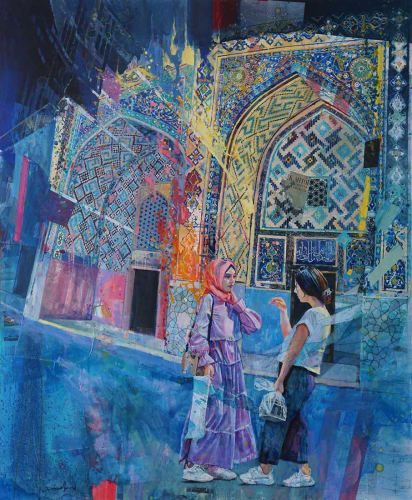David Martin: Silk Roads: New Work From Travels in Central Asia
David Martin (b.1975) is an artist living and working in Edinburgh. In his painting practice he aims to make work that reflects the state of the world we live in. He has a particular interest in travelling to places where he can explore themes of global change and transformation, and he approaches this by spending time drawing, photographing and documenting everyday life, using the material he gathers to create mixed media paintings that layer these narratives of personal encounter with material, signs and imagery indicating broader themes encompassing geopolitical shifts and societal transformation.
Silk Roads
"Uzbekistan is a relatively modern country, declaring independence in 1991 in the aftermath of the collapse of the Soviet Union. However, the cities of this new nation are ancient, marking important points along trading routes that have been there for as long as people have moved across the great landmass of Asia. For centuries Samarkand, Bukhara and Khiva would have felt like the centre of the world when they controlled the silk trade between the Far East and the less civilised backwaters of Europe, and in the late 14th Century were indeed at the centre of the most powerful empire on Earth, ruled by Timur, or Tamerlane as he was known in the West, who made Samarkand his capital. As his brutal empire faded however, the cities remained important centres of global trade until they were subsumed into the expanding Russian Empire in the 19th Century, eventually becoming part of the Uzbek Soviet Socialist Republic 100 years ago, as part of the USSR. Uzbekistan declared independence in 1991 and was ruled by Islom Karimov, the former first secretary of the Uzbek Soviet Republic, a brutal dictator by all accounts. The country became isolated and difficult to visit, but since Karimov's death in 2016 the country has started to emerge from his shadow and is looking to a bright future.
I visited Uzbekistan in the summer months of 2022 when this desert country is at its hottest and the light is at its most blinding. In Samarkand, Bukhara and Khiva I found myself amongst the most incredible historic architecture and monuments that had endured through so much turbulent history, and now seemed to serve as a connection to an ancient past in the midst of this new dawn. It seemed to me I was at a crossroads in time, as the Russian cultural legacy is beginning to fade and be replaced by Uzbek Identity. I was travelling only a few months after Russia's full-scale invasion of Ukraine, itself a former Soviet Republic, and so this sense of cultural shift was brought into focus for me and became a significant part of how I experienced the place and its people.
I was mesmerised by the intricate pattern and Islamic tile designs adorning the ancient architecture, which dazzles and seems to break up the enormous flat surfaces of the buildings, turning them into dynamic forms that glint and dissolve and re-form in the brutal light. I wanted to play this off against depictions of everyday people I came across to capture something of the positive and dynamic feeling of change in the air, and by building my compositions up using pages from old Russian textbooks I bought from Ukraine, I wanted to embody something of the significant cultural shift in the region.
Every painting in the exhibition tells a story for me; even a simple chance encounter or a glimpsed view contains a world as I see it, and some paintings are just this. However, there are other narratives at play too, such as my trip to the environmental devastation of the area that used to be the Aral Sea; formerly the world's third-largest inland sea now almost entirely dried up and gone, as a result of Soviet and post-Soviet environmental mismanagement. And then there are the conversations. This project started out as a series of paintings and studies of conversations: who was talking to whom, were they similar or different, and what were they saying? I like to think that there is an exchange of something; ideas, maybe hopes and new dreams, exchanging thoughts and making change as people have always done along the Silk Roads." David Martin, 2024



























